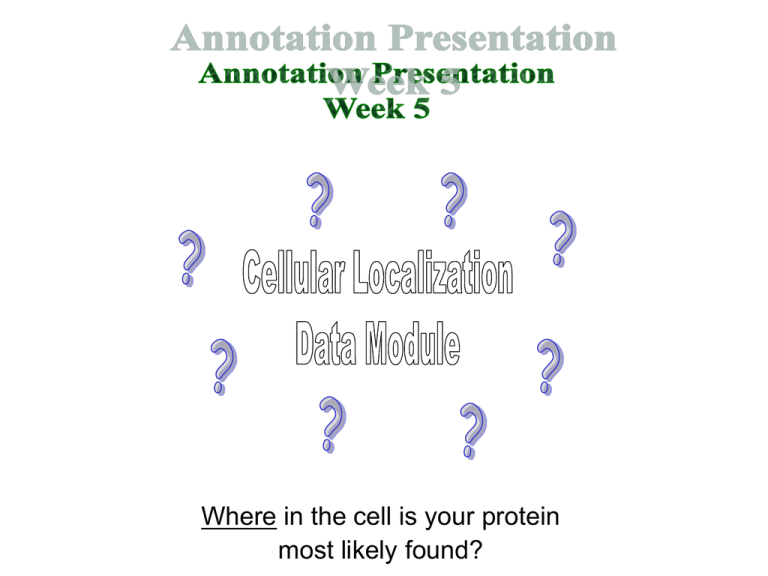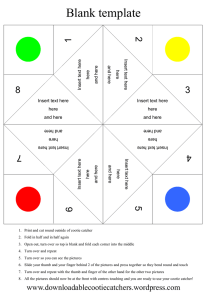
Where in the cell is your protein
most likely found?
Where Are Proteins Located?
• All proteins are synthesized in the cytoplasm.
• Proteins with export signals can be directed to other
cellular locations:
– cytoplasm, cytoplasmic membrane, outer membrane or
periplasm of Gram (-) bacteria, cell wall, or as secreted
products in extracellular space
Insert Figure 1 from Gardy and Brinkman (2006)
Methods for predicting bacterial protein subcellular localization.
Nature Reviews Microbiology 4: 741-751.
Gram Positive
Cells
Gram Negative
Cells
What do we know about Planctomyces limnophilus?
Is it Gram-positive or Gram-negative?
Where is it possible for proteins to be located for P. limnophilus?
To answer these questions, we need to know more details about the organism. . .
Recall: Planctomyces limnophilus DSM 3776
• budding, stalked bacterium
isolated from the surface of
a eutrophic freshwater lake
in Holstein, Germany
Insert map of Germany from
www.mapsofworld.com
Insert Figure 1D from Hirsch P and Müller M (1985)
Planctomyces limnophilus sp. nov., a stalked and
budding bacterium from freshwater.
System. Appl. Microbiol. 6: 276-280.
Characteristics of Planctomyces
• form rosettes (star-like form) with cells
connected by non-cellular, protein stalk
Insert Figure 1 from Fuerst (1995)
The planctomycetes: Emerging models for microbial ecology, evolution, and cell biology.
Microbiology 141: 1493-1506.
• When initially discovered
were thought to be fungal conidia
Planctomyces possess internal,
membrane-bound compartments
(blurs the boundary between prokaryotes & eukaryotes)
• some bound the nucleoid
• Gemmata obscuriglobus
Insert Figure 17-34b from
Brock Biology of Microorganisms 11/e
© 2006 Pearson Prentice Hall, Inc.
• some partition metabolic functions
• Brocadia anammoxidans
• carries out anaerobic oxidation of
NH3 to N2 within enclosed structure
called an anammoxosome
Insert Figure 12.87 from
Brock Biology of Microorganisms 11/e
© 2006 Pearson Prentice Hall, Inc.
Planctomyces limnophilus DSM 3776
young
bud
nearly
mature
bud
mature
mother
cell
• do not form endospores
Insert Figure 1 (panels A-D) from
Hirsch P and Müller M (1985)
Planctomyces limnophilus sp. nov.,
a stalked and budding bacterium
from freshwater. System. Appl.
Microbiol. 6: 276-280.
mature
cell with
short stalk
& fibrous
holdfast
• form red colonies
mature
cell with
long stalk
• mature cell shape & size
• ovoid to spherical
• 1.1 – 1.5 μm
• attach to surfaces using fibrous
holdfast at end of long, rigid stalk
composed of twisted fibrils
• stalk made of protein
• multiply by yeast-like budding
What other organisms use asymmetric cell division?
Budding bacterium:
Planctomyces limnophilus
Insert Figure 1 (panels A-B) from
Hirsch P and Müller M (1985)
Planctomyces limnophilus sp. nov.,
a stalked and budding bacterium
from freshwater. System. Appl.
Microbiol. 6: 276-280.
Budding yeast (eukaryote):
Saccharomyces
cereviseae
Insert image of budding yeast cell
Cellular characteristics of Planctomyces
P. maris
• surface appendages
o stalk with holdfast
o flagellum
o pili
o fimbriae
Neisseria gonorrhoeae
Insert Figure 12.86 from
Brock Biology of Microorganisms 11/e
© 2006 Pearson Prentice Hall, Inc.
• lack peptidoglycan in cell wall
o Like mycoplasmas & clamydiae
o consequently stains Gram-negative
Does this imply P. limnophilis is
Gram-negative? Why or why not?
o naturally resistant to penicillin
Insert image from
ASM Microbelibrary.org
Recall: Gram-negative cells are red
Cellular characteristics of Planctomyces
• cell membrane
o lipids with glycerol esters of
fatty acids
composition consistent with that
of Bacteria & Eukarya
major phospholipids are palmitic,
palmitoleic, & oleic acids
• some evidence for lipid A
Does this mean P. limnophilus
has an outer membrane (LPS)
like Gram-negative cells?
Insert Figure 3-7 parts 1 & 2 from
Brock Biology of Microorganisms 11/e
© 2006 Pearson Prentice Hall, Inc.
Cellular characteristics of Planctomyces
• Subunit composition of RNAP
consistent with Bacteria
Insert Figure 11-19 from
Brock Biology of Microorganisms 11/e
© 2006 Pearson Prentice Hall, Inc.
Insert Figure 8-5C from
Microbiology – An Evolving Science
© 2009 W.W. Norton & Company, Inc.
Ec – E. coli (Bacteria)
Hs – Halobacterium salinarum (Archaea)
Sa – Sulfolobus acidocaldarius (Archaea)
Sc – Saccharomyces cerevisiae (Eukarya)
Why is this information important?
Is it Gram-positive or Gram-negative?
Where is it possible for proteins to be located for P. limnophilus?
• Planctomycetes have distinct cellular characteristics
Absence of peptidoglycan but possible presence of lipid A in cell envelop
What does the structure of the cell envelop in P. limnophilus
resemble? Gram-positive or Gram-negative?
Exhibit budding-like mechanism for cell division (like eukaryotes)
Have internal membranes (compartmentalization like eukaryotes)
Is there an evolutionary relationship to origin of eukaryotic nucleus?
Will sorting signals resemble those in bacteria or eukaryotes?
• At least 8% of the Rhodopirellula baltica proteome exhibits
homology with eukaryotic genes (Glockner et al. 2003)
HGT or genes derived from the universal ancestor of all 3 domains?
Fuerst (2005)
Annu. Rev. Microbiol. 59: 299-328.
Glockner et al. (2003)
PNAS 100: 8298-8303.
How do we figure out where
proteins are located?
Transmembrane Helices Hidden Markov Models
(TMHMM)
Does my protein have transmembrane helices?
Signal Peptide (SignalP)
Does my protein have a sequence of amino acids that
target it to a particular place in or outside the cell?
PSORT-B
Where is my protein most likely located? The cytoplasm? The
membrane? The periplasm? The cell wall? The extracellular space?
Phobius
Does my protein have transmembrane helices & signal peptides? Do
these results agree with TMHMM and SignalP?
Transmembrane Helices Hidden
Markov Models (TMHMM)
• A Hidden Markov Model is a probabilistic model developed from
observed sequences of proteins of a known function.
• TMHMM is a tool used to predict the presence of transmembrane
helices in proteins. The results will indicate the segments of the
protein that lie inside, outside or within the membrane.
Click link found in
Lab Notebook
TMHMM Database Search
Enter “Protein
Sequence” in
FASTA format
“CLICK”
**Make sure Javascript is enabled on your computer to read output
TMHMM result
Predicted number of TMHs
(transmembrane helices)
Boundaries for
THM amino acids
Copy/paste this
information into
the box in your
lab notebook
Interpreting the TMHMM plot
Schematic that
summarizes
discrete regions
within the protein;
not probability.
0.75
The 12
predicted
TMHs
X-axis: the amino acid number
Residue number
Y-axis: the probability that the amino acid is located within
the membrane, outside the cell, or in the cytoplasm
Ex: If probability >0.75, then result is significant. The
maximum probability is 1, so the probability that amino
acids #1-#20 are “inside” is 100%
Transmembrane
Inside (cytoplasm)
Outside
(extracellular,
periplasm)
By analyzing the
probabilities
shown on the
plot, you can
determine where
segments within
the protein are
located.
membrane
cytoplasm
Inserting the TMHMM plot into your notebook
Save image in GIF format
to your computer and
insert into Lab Notebook
…and the comments
Summarize
your analysis
of the
TMHMM plot
in the box
provided for
“comments”.
Recording results in your Lab Notebook
Confirm you record
the number of TMHs,
with a text description
of the boundaries
for each TMH
Insert the TMHMM plot
Examine the plot &
summarize results, with
a confidence rating
based on the
probability score.
Assess how its
structure is related to
assigned function.
OID 2500607071
SignalP
• A Signal Peptide (SignalP) is a series of amino acids in the
polypeptide that directs the protein to its proper cellular location
• Ex: Single TMH at N-terminus of protein that gets cleaved by
proteases once inserted into membrane
Click link found in
Lab Notebook
Locating proteins in the cell using TargetP, SignalP, and related tools
Olof Emanuelsson, Søren Brunak, Gunnar von Heijne, Henrik Nielsen
Nature Protocols 2, 953-971 (2007).
SignalP Database Search
• Keep in mind…
• Planctomyces have characteristics of both Gram-negative bacteria
(lack peptidoglycan in cell envelop) & eukaryotic organisms
(internal membranes, budding mechanism for cell division)
Try Gramnegative
database first
“CLICK”
Signal peptide should be
in N-terminus of your protein;
No need to scan full length
Signal P (Gram - )
0.75
0.50
Represents Probability
- Signal peptide
cleaved by
proteolytic
enzymes
- N-terminus of
signal peptide
- Hydrophobic
Region (TMH)
- C-terminus of
signal peptide
Position of Amino Acid
Look for Probability exceeding 0.50
threshold. If not, go back and select
“eukaryotes” as an organism group
SignalP Database Search
• If no significant results obtained searching the Gram-negative database,
next try the eukaryotic database. . .
Change this
selection only
“CLICK”
Signal P (Eukaryote)
0.75
0.50
What would you conclude
for this protein?
- Signal peptide
cleaved by
proteolytic
enzymes
- N-terminus of
signal peptide
- Hydrophobic
Region (TMH)
- C-terminus of
signal peptide
If the probability is >0.50, then the
results suggest that your gene
encodes a signal peptide. Higher
confidence in probability score if >0.75
Possible protease cleavage
site if probability > 0.75
Recording results in your Lab Notebook
Insert requested information.
SAVE image in
GIF format then
insert image
inside box.
OID 2500607071
PSORT-B
• Another useful tool in predicting bacterial protein localization
• The output is TEXTUAL, but the information still will be helpful
Click link found in
Lab Notebook
Select “Negative”
for Gram stain
Enter “Protein
Sequence” in
FASTA format
“CLICK”
Recording results in your Lab Notebook
Enter in your
Lab Notebook
Where this
protein is
predicted to
be located in
the cell
Phobius
• Graphical output
• Combination of transmembrane topology (TMHMM)
and signal peptide predictor (SignalP)
“Click”
“Click”
Copy/paste your
amino acid sequence
in Fasta format
Query Results
Text listing predicted
locations of TMHs,
intervening loops,
and signal peptide
Graphical
summary
Interpreting the Phobius Plot
• Y axis shows
probability
0.75
GRAY regions =
transmembrane helices
Green lines =
cytoplasmic regions
Blue lines =
non-cytoplasmic regions
Red lines =
signal peptides
• X axis shows
amino acid position
By analyzing the
probabilities
shown on the
plot, you can
determine where
segments within
the protein are
located.
membrane
cytoplasm
Recording results in your Lab Notebook
Add heading
Copy/paste text description
into new box
OID 2500607071
Recording results in your Lab Notebook
SAVE image in PNG
format then insert into
Notebook inside box.
OID 2500607071
Finishing Up Cellular Localization Module
Now that you’ve finished TMHMM, SignalP, PSORT, and Phobius, you should
have an idea about the cellular localization of the protein encoding by your gene.
THINGS TO CONSIDER:
• Did TMHMM indicate any transmembrane helices? If so, how many?
• Did SignalP show evidence of a signal peptide at N-terminus?
• Where did PSORT predict the protein was located in the cell?
• Were Phobius results consistent with TMHMM and SignalP results?
Enter your conclusion about where you would expect to
find the protein under the Hypothesis section of this module







